- A dog starts at the origin and runs forward at 6 m/s for 1.5 s and then turns around to fetch the ball by running backward at 7 m/s for 3 s. If the dog runs back to the origin at 4 m/s, then how much time has elapsed between the start and when he returns with the ball?
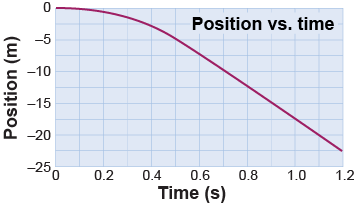
- The position vs. time graph above represents the motion of a foam ball after being dropped. What is the instantaneous velocity at 0.8 s?
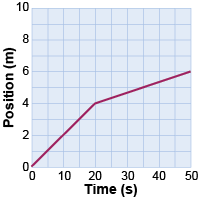
- In the position versus time graph above, how far does the object travel in the first 35 s?
- The cheetah, the fastest land animal, can sprint at 30 m/s. Could the cheetah get a speeding ticket on a highway where the speed limit is 55 mph?
 A bicycle starts 50 m from an intersection. Ten seconds later the bicycle is 85 m from the same intersection. What is the slope of the bicycle’s position versus time graph 5 s after it starts? Assume constant velocity motion. A bicycle starts 50 m from an intersection. Ten seconds later the bicycle is 85 m from the same intersection. What is the slope of the bicycle’s position versus time graph 5 s after it starts? Assume constant velocity motion.

- Mike drove 70 km due west and then 100 km due east.
- What is his total distance traveled?
- What is his total displacement?
- If Mike took 3 hr to complete the trip, what was his average speed?
- What was his average velocity over the 3 hr trip?
| | 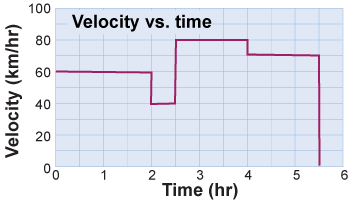
- How far does the car travel between 1 hr and 3 hr according to the velocity versus time graph above?
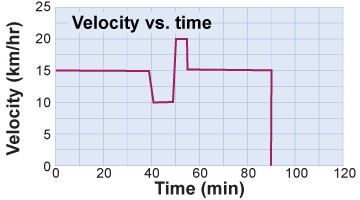
- The velocity versus time graph above shows a bicycle trip. Use the graph to calculate the following.
- How many kilometers does the cyclist travel?
- What is the cyclist’s final position?
- Which segment of the trip is most likely to have been downhill?
 An object that starts at a position of 5 m and travels for 3 s at a velocity of −9 m/s ends up at what position? An object that starts at a position of 5 m and travels for 3 s at a velocity of −9 m/s ends up at what position?
 How long does it take to ride 5 miles on a bicycle going 20 mph? How long does it take to ride 5 miles on a bicycle going 20 mph?
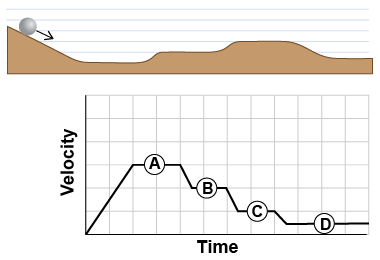
- A ball rolls along the track shown. Use what you know about how speeds change on hills to determine which of the four places (A, B, C, or D) on the graph of velocity versus time cannot be correct.
|

